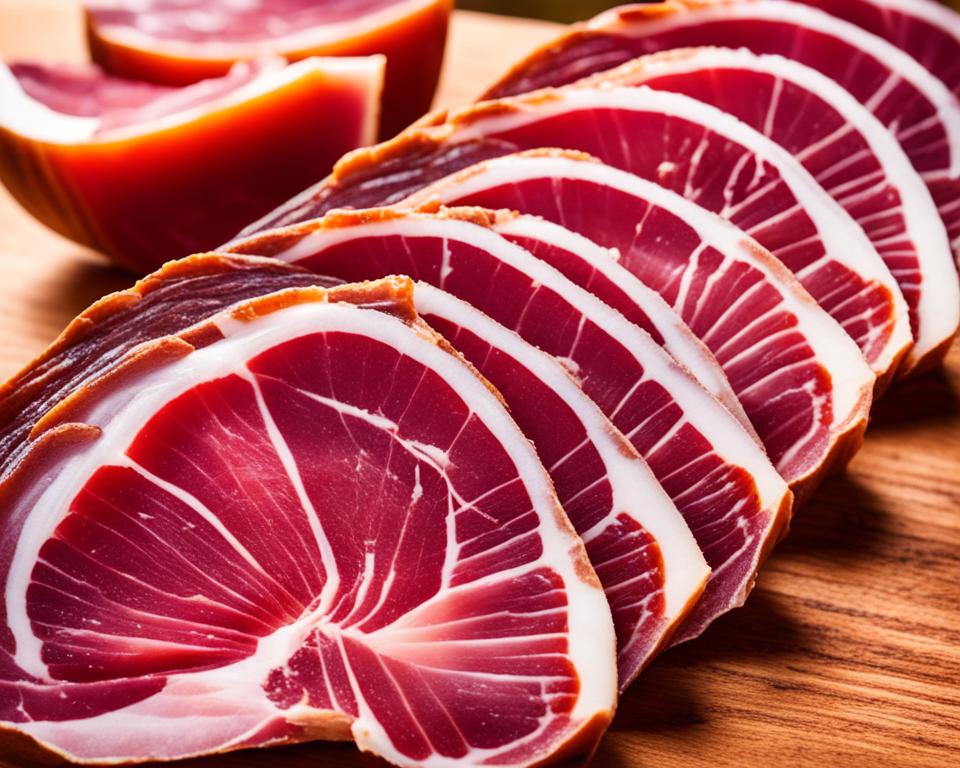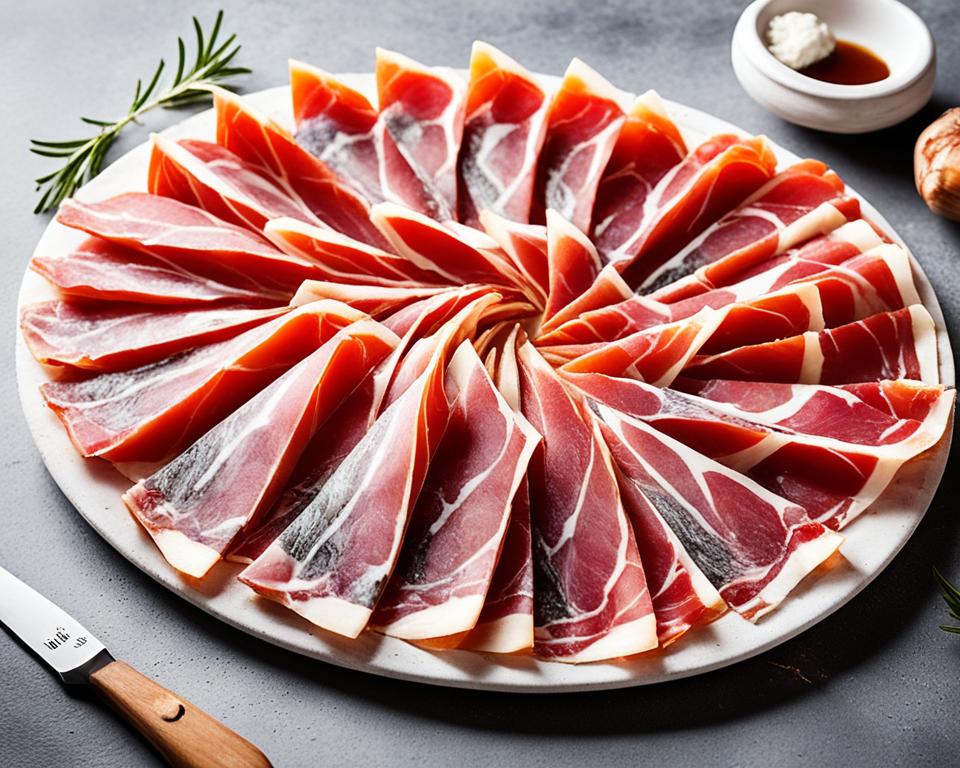
Iberian ham, also known as jamón ibérico or pata negra, is a famous cured meat from Spain. It comes from the Iberian Peninsula. This ham is loved around the world for its amazing taste, texture, and quality. It’s considered a top culinary treasure.
This article will talk about its history, how it’s made, and what makes Iberian ham so special. It’s a true Spanish food masterpiece.
Read interesting things at : luoghievisioni
Key Takeaways
- Iberian ham is a renowned cured meat delicacy from Spain, known for its exceptional flavor and quality.
- It is also referred to as jamón ibérico or pata negra, reflecting its distinct characteristics.
- Iberian ham is a prized culinary treasure, valued worldwide for its unique production process and heritage.
- This article explores the history, production, and distinctive features that make Iberian ham a true Spanish gastronomic masterpiece.
- The article aims to provide a comprehensive understanding of this prestigious cured meat and its significance in Spanish cuisine.
What is Iberian Ham?
Iberian ham is also known as jamón ibérico or pata negra. It’s a top-notch dry-cured ham from Spain. It comes from the black Iberian pig and is famous for its deep flavor and smooth texture. This makes it a top choice for food lovers around the globe.
The Essence of Spanish Culinary Heritage
Iberian ham is more than just food; it’s a piece of Spain’s long history of food. Making this cured meat is an art that has been perfected over many generations. It shows respect for the land, the animals, and the old ways of making food. From the pigs eating acorns to the slow curing process, every step makes this ham special.
Defining Characteristics and Production Process
- The Iberian pig is a special breed from the Iberian Peninsula. It has a black or reddish-brown coat and eats acorns, known as bellotas.
- Making Iberian ham is hard work and can take up to 36 months. This depends on the type of ham.
- While curing, the ham is salted, dried, and aged slowly. This makes the flavors develop and the texture soft and smooth.
- The end result is a delicacy that shows off the region’s unique taste and food traditions.
Iberian ham is the essence of Spanish cooking. It shows Spain’s dedication to quality, tradition, and culinary greatness.
History and Tradition of Iberian Ham
The history of Iberian ham goes way back to ancient times. It started with the Iberian and Roman civilizations. They used to make and cure it, and this tradition has lasted for centuries.
Over time, making Iberian ham became an art passed down through families. It has changed a bit but kept its core traditions. The way they cure and age it has made it what it is today.
“Iberian ham is not just a food, it’s a testament to the rich cultural heritage and gastronomic legacy of Spain.”
Iberian ham is a big part of Spanish culture. It’s made in places like Guijuelo and Jabugo, where people take great pride in it. It shows the pride of the regions and the country.
Today, the old ways of making Iberian ham still guide its production. Every step, from picking the pigs to aging the meat, shows Spain’s rich food history. It’s a tradition that honors the past and delights the taste buds.
Types of Iberian Ham
Iberian ham is a beloved delicacy in Spain, with different types that highlight its diversity and richness. The main types are Jamón Serrano and Jamón Ibérico de Bellota. Each has its own unique taste and way of making it.
Jamón Serrano
Jamón Serrano, also called “mountain ham,” is more common and less expensive. It comes from white pigs that eat a mix of foods. The curing process includes salting, drying, and aging for at least 12 months, sometimes up to 15 months or more.
This makes the ham milder and more delicate in taste. It has a lean texture and a slight sweetness. It goes well with many foods and tastes.
Jamón Ibérico de Bellota
Jamón Ibérico de Bellota is the top Iberian ham. It comes from black Iberian pigs that eat a lot of acorns, or bellotas, before they are slaughtered. This diet gives the meat a special flavor.
The curing of Jamón Ibérico de Bellota is a long and careful process, taking 36 to 48 months. This results in a ham that is rich in umami taste, has a soft texture, and a subtle sweetness. It’s unlike any other ham.
“Jamón Ibérico de Bellota is the crown jewel of Spanish gastronomy, a symphony of flavors that transports you to the heart of the Iberian Peninsula.”
Whether you like the more common Jamón Serrano or the luxurious Jamón Ibérico de Bellota, these two types of types of iberian ham show the rich variety of Spain’s cured meats.
Iberian Ham: A Delicacy Like No Other
Iberian ham is considered one of the best cured meats globally. It’s known for its top-notch quality and unique taste. The Iberian pig’s special genes, its diet of acorns, and the careful curing process make it a standout. This makes Iberian ham a key part of Spanish cuisine and a favorite delicacy worldwide.
The making of Iberian ham shows the hard work and skill of Spanish craftsmen. They pick the best Iberian pigs and use detailed curing methods. Each step is done with great care to ensure the best taste and quality. This results in a delicacy that is both complex and exciting, with a mix of aromas and a soft texture.
The taste of Iberian ham comes from the pigs eating acorns. This gives the meat a rich, nutty flavor and a deep reddish-pink color. The slow curing process also makes Iberian ham stand out from other cured meats. It’s a true culinary gem.
“Iberian ham is not just a food; it’s a work of art, a reflection of the rich cultural heritage and culinary traditions of Spain.”
People all over the world love Iberian ham for its unmatched quality. They enjoy it on its own or as part of Spanish cuisine. Iberian ham is a true culinary delight that keeps food lovers coming back for more.
The Curing Process: A Labor of Love
The making of Iberian ham is a detailed and long process. It needs skill, patience, and a love for tradition. It starts with salting and drying the hams. These steps remove moisture and add flavor.
Salting and Drying
The first step is salting the Iberian hams. This stage removes moisture, preserves the meat, and gives it flavor. The hams get rubbed with just the right amount of salt. Then, they rest for weeks, letting the salt work deep into the meat.
After salting, the hams dry for 6 to 24 months. They hang in places with good air flow. Here, they face the changing weather, which makes their flavor strong and their texture unique.
Aging and Maturation
The last steps are aging and maturing the hams. This can take up to 36 months. During this time, the hams change flavor and texture. They are watched over and moved in special cellars to get just the right conditions.
The curing of Iberian ham is a labor of love. It shows the skill and tradition of its makers. The result is a delicacy that honors Spain’s culinary past.
“The curing of Iberian ham is a symphony of patience, meticulousness, and an unwavering respect for tradition. Each step in the process is a masterful dance, where the interplay of time, temperature, and humidity creates a delicacy that is truly unparalleled.”
Distinctive Flavor and Aroma
Iberian ham is a treasure from Spain’s food world. It’s known for its amazing taste that grabs your attention. The Iberian pig’s special diet and genetics, along with careful curing, make the ham’s flavor so rich and complex.
The iberian ham has a nutty and slightly sweet taste, with hints of acorn and cured meat. Sometimes, you might catch a smoky note. This comes from the pig eating acorns, herbs, and other wild plants. The slow curing process also makes the ham’s flavor better, blending natural sugars and amino acids together.
The iberian ham’s aroma is just as special, with smells of savory, umami, and a bit of sweetness. This shows the hard work in curing the ham, aging and drying it to perfection.
“The iberian ham is a true gastronomic masterpiece, a harmonious union of flavor and aroma that transports the senses to the heart of Spain’s culinary heritage.”
Enjoying iberian ham alone or with other foods, its unique flavor and aroma make it a true delicacy. It excites the taste buds and brings joy to the senses.

| Flavor Profiles | Aroma Notes |
|---|---|
| Rich, nutty, and slightly sweet | Savory, umami, and slightly sweet |
| Subtle notes of acorn, cured meat, and smokiness | Complex blend of natural aromas |
Nutritional Benefits of Iberian Ham
Iberian ham is more than just a tasty treat from Spain. It’s also a food that’s good for you. This cured meat is packed with health benefits, making it a great choice for a balanced diet.
This ham is full of high-quality protein. It has the amino acids your muscles need to grow and stay strong. The way it’s cured also makes its nutrients easier for your body to use, making it a better choice than other cured meats.
Iberian ham is also a great source of vitamins and minerals. It has vitamins B1, B6, and B12. These vitamins are important for energy, making red blood cells, and keeping your nerves working right.
It’s also loaded with monounsaturated fats, especially oleic acid. These fats are good for your heart and brain. They can lower cholesterol, cut the risk of heart disease, and even help you think better.
| Nutrient | Amount per 100g of Iberian Ham | % Daily Value |
|---|---|---|
| Protein | 28g | 56% |
| Vitamin B1 (Thiamine) | 0.8mg | 67% |
| Vitamin B6 | 0.4mg | 20% |
| Vitamin B12 | 1.5μg | 63% |
| Monounsaturated Fats | 42g | N/A |
Adding Iberian ham to your meals means you get to enjoy great taste and health benefits. It’s perfect whether you eat it alone or with other foods and drinks. Iberian ham is a healthy and delicious choice.
Pairing Iberian Ham: Wine and Beyond
Iberian ham’s complex flavors and textures make it great with many foods. It goes well with bold Spanish red wines and traditional Spanish dishes. The rich, nutty taste of Iberian ham matches a wide range of foods.
Wine Recommendations
For wine, Iberian ham pairs well with Spanish red wines. These wines have bold, fruity tastes. Some top pairings are:
- Rioja: The intense, oak-aged flavors of Rioja wines are perfect with Iberian ham’s savory taste.
- Ribera del Duero: The rich, intense red wines from this area match the complex flavors of Iberian ham well.
- Tempranillo: This grape variety in many Spanish red wines has a ripe, fruity taste. It goes well with Iberian ham’s nutty and sweet-salty flavors.
Other Complementary Foods and Beverages
Iberian ham also goes well with other Spanish foods and drinks:
- Manchego Cheese: The firm, slightly salty cheese and its nutty taste match the cured ham well.
- Crusty Bread: A simple slice of crusty bread is perfect for enjoying the delicate flavors of Iberian ham.
- Sherry: Sherry’s complex, dry, and nutty taste goes great with Iberian ham, making a perfect pair.
Iberian ham is versatile and can be enjoyed in many settings. It’s great for intimate gatherings or grand celebrations. Its unique flavors shine when paired with wine, cheese, and other Spanish delicacies.
“Iberian ham is not just a cured meat – it’s a culinary symphony that resonates with the flavors and traditions of Spain.”
Slicing and Serving Iberian Ham
The art of slicing and serving Iberian ham is key to enjoying its flavors and texture. This Spanish delicacy needs a gentle touch to slice it into thin pieces. These slices should melt in your mouth effortlessly.
To slice Iberian iberian ham, use a sharp, long knife or a slicing ham slicer. Slice the ham into thin, delicate pieces. This keeps the meat intact and brings out its rich flavors.
It’s best to serve Iberian ham at room temperature. This lets its flavors and aroma come out fully. The ham’s salty, nutty, and sweet tastes create a unique experience for your taste buds.
| Proper Slicing Techniques for Iberian Ham | Ideal Serving Temperature |
|---|---|
|
|
Learning to slice and serve Iberian ham well is the last step to enjoying this Spanish delicacy. By following traditional methods, you can fully appreciate its unique flavors and textures. Iberian ham is truly a culinary treasure.
“The secret to enjoying Iberian ham lies in the careful slicing and serving – it’s a ritual that must be honored to fully appreciate this gustatory delight.”
Iberian Ham Production Regions in Spain
The making of iberian ham happens mainly in certain areas of Spain. These places are known for their special climates and how they raise the pigs. Guijuelo and Jabugo are two top spots for iberian ham. They have strict rules and certifications to make sure the hams are top quality and real.
Guijuelo
Guijuelo is in western Spain and is famous for its iberian ham. The area’s hot summers and cold winters are perfect for curing the ham. This makes the iberian ham from Guijuelo taste and feel unique. Only the best iberian ham leaves this area.
Jabugo
Jabugo is in southern Spain’s Andalusia region and is the heart of iberian ham making. The mild weather and lots of oak forests help make the iberian ham from Jabugo special. For years, the production region has used curing methods that make its iberian ham stand out.
| Iberian Ham Production Region | Key Characteristics |
|---|---|
| Guijuelo | – Located in western Spain – Unique microclimate with hot summers and cold winters – Strict regulations govern production methods – Renowned for exceptional flavor and texture |
| Jabugo | – Situated in the Andalusia region of southern Spain – Mild climate and abundance of oak forests – Long-standing tradition of curing techniques – Considered the epicenter of Iberian ham production |
“The iberian ham from Guijuelo and Jabugo are the crown jewels of Spanish culinary heritage, each with its own unique character and story.”
Iberian Ham in Spanish Cuisine
Iberian ham is a key part of Spanish food. It’s used in many dishes, from simple snacks to complex meals. This special ham is known for its rich taste and versatility.
At tapas, iberian ham is a big hit. It’s served with manchego cheese, olives, and bread. These small plates let everyone enjoy the ham’s tender slices.
But iberian ham isn’t just for tapas. It’s also great in many other dishes. You can put it on pizzas, in paella, or in stews. Its strong taste makes any dish better.
Iberian ham is a favorite in spanish cuisine. It’s loved for its unique taste and important role in Spanish food culture.
Buying and Storing Iberian Ham
When looking for iberian ham, it’s key to buy from trusted suppliers. This cured meat is a gem of Spanish food culture. It needs careful handling from purchase to storage to keep its great taste and texture.
Search for iberian ham with the Denominación de Origen (DO) or Indicación Geográfica Protegida (IGP) labels. These labels mean the ham is real and meets high quality standards. Find retailers or online shops known for their quality iberian hams.
Proper Storage for Optimal Enjoyment
After getting your iberian ham, make sure it’s stored right. This meat likes a cool, dark place with good air flow. Keep it at 55°F to 65°F (12°C to 18°C) with humidity between 60% and 80%.
- Don’t put the ham in direct sunlight or near heat, as it can dry out too fast and lose flavor.
- If the ham is whole, use a special ham holder or hang it in a ham cellar or pantry. For sliced iberian ham, keep it in a sealed container or wrap it in plastic or wax paper.
- With the right storage, an iberian ham can last up to 2 years. It’s a great buy for food lovers.
By knowing how to buy and store iberian ham, you can enjoy its unique taste for a long time. This makes your meals more special with every slice.

Iberian Ham Festivals and Events
Iberian ham is a treasured Spanish food celebrated with festivals and events across the country. These events let locals and visitors dive into the history, making, and culture of this loved food.
The Salón Gourmet in Madrid is a top event for Iberian ham lovers. It brings together thousands from around the world. Here, experts compete in slicing Iberian ham perfectly.
In Guijuelo, the Jamón de Guijuelo Festival honors the area’s famous Iberian ham. Guests can try different tastes, learn about curing, and see how the ham is sliced by hand.
In Andalusia, Jabugo’s Feria del Jamón Ibérico celebrates Jamón Ibérico de Bellota. It offers tastings, wine pairings, and demos by top curers.
| Festival | Location | Highlights |
|---|---|---|
| Salón Gourmet | Madrid | Ham-cutting competitions, tastings, and workshops |
| Jamón de Guijuelo Festival | Guijuelo | Tastings, curing technique workshops, hand-slicing demonstrations |
| Feria del Jamón Ibérico | Jabugo | Gourmet ham and wine pairings, curing demonstrations |
These festivals and events celebrate Spain’s rich food culture. They give fans and newcomers a deep dive into the world of Iberian ham.
Asian Food Thailand: Discover Authentic Thai Cuisine Flavors
Conclusion
Iberian ham is a true culinary treasure. It has won the hearts of food lovers worldwide with its amazing flavor and texture. This Spanish delicacy is the peak of cured meat excellence.
Exploring iberian ham takes you through a world of history, passion, and culinary art. It’s a key part of Spanish cuisine. You’ll see how it’s made with care and tradition.
The story of iberian ham shows the hard work and skill of Spanish producers. They keep this tradition alive and make it better. This versatile ham is loved for its flavor and adds joy to many dishes.
As you try iberian ham, you’ll learn about its history and flavors. You’ll see why it’s a symbol of Spanish food culture. It’s a journey that’s both tasty and enlightening.
The true value of iberian ham is its taste and the culture behind it. The artisans who make it are passionate about preserving this tradition. When you eat it, you’re tasting a piece of Spain’s heritage.






